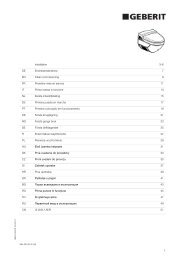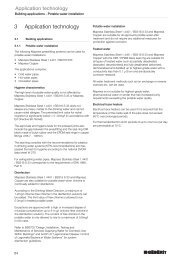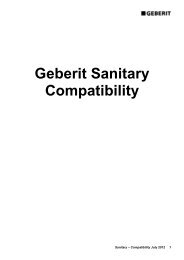Geberit View 2012
Geberit View 2012
Geberit View 2012
Create successful ePaper yourself
Turn your PDF publications into a flip-book with our unique Google optimized e-Paper software.
Spectrum Environment<br />
↑ Unusual stylistic elements and a “green” building: The Mauritius Commercial Bank fascinates with its elliptic shape and the consistent implementation<br />
of resource-saving concepts.<br />
An ellipse that is<br />
something else<br />
Mauritius Commercial Bank, Mauritius<br />
The new headquarters of<br />
the Mauritius Commercial<br />
Bank has attracted a great<br />
deal of interest. On the one<br />
hand, this is because of<br />
its unusual architecture. On<br />
the other hand, the building<br />
meets high sustainability<br />
standards and has been<br />
awarded the GREEN STAR<br />
and the BREEAM label.<br />
Five hours by plane from Johannesburg in<br />
South Africa, in the middle of the Indian<br />
Ocean, lies the island of Mauritius: tropical<br />
climate with an average temperature of<br />
23.3 degrees Celsius, dry winters and wet<br />
summers. The heating of buildings is of no<br />
interest in this region. The question is far<br />
more, how one can provide resourcesaving<br />
cooling. One answer to this is provided by a<br />
new building that already stands out in its<br />
surroundings simply by its unusual architecture:<br />
the new headquarters of the Mauritius<br />
Commercial Bank. The project, which<br />
was implemented in 2011, was conceived by<br />
the architect Jean François Koenig.<br />
Energy thanks to its own solar park<br />
The unique Green Building takes into account<br />
all aspects of sustainable building<br />
and meets high social and economic standards.<br />
“In addition to saving energy and water,<br />
these also involve acoustic insulation<br />
and fire protection, safety, waste disposal<br />
and quality of life,” explains Jean François<br />
Koenig, who studied architecture in London<br />
and who has had an office of his own on<br />
Mauritius since 1987.<br />
The building is conceived in such a way that<br />
it uses around one third less energy than<br />
conventional buildings. The elliptical shell<br />
Mauritius Commercial Bank<br />
Headquarters<br />
Building owner: Mauritius<br />
Commercial Bank Ltd (MU),<br />
Architect: Jean François Koenig,<br />
Montagne Longue (MU)<br />
Completion: 2011<br />
Sanitary engineer: Arup Sigma Ltd,<br />
Port Louis (MU); Proburo Ltd, Port<br />
Louis (MU)<br />
Plumber: Plumbelec Co. Ltd,<br />
Curepipe (MU)<br />
<strong>Geberit</strong> know-how<br />
GIS installation system<br />
Electronic urinal flush control<br />
and lavatory tap<br />
P-trap<br />
PE-HD piping system<br />
Pluvia roof drainage system<br />
Mepla piping system<br />
→ Five glass rings pass around<br />
the ellipse and bring light into the<br />
central building section.<br />
is made of concrete, aluminium plates and<br />
an additional insulation layer, which together<br />
make up a good insulation layer. Daylight<br />
comes into the building not only through<br />
the front and rear facades, but also through<br />
five glass rings that penetrate the ellipse all<br />
around. The glass of the rings is made of<br />
energyfriendly dark glass, which protects<br />
the rooms against overheating.<br />
Economical handling of drinking water<br />
Workplaces for 1,100 employees are located<br />
in the 40metrehigh banking complex,<br />
along with two large auditoriums, training<br />
rooms and a canteen. The building’s own<br />
solar park provides the majority of the required<br />
energy. And wherever it is expedient,<br />
rainwater and grey water are used instead<br />
of drinking water.<br />
The rainwater is collected on the roof, channelled<br />
into four large water tanks and used<br />
instead of drinking water for toilet flushes,<br />
for example. Drinking water itself is available<br />
only for washing hands and in the kitchen.<br />
And there, the taps are equipped with electronics,<br />
which prevent unnecessary water<br />
consumption. And the drinking water is itself<br />
not lost, but is also collected instead in tanks<br />
and cleaned with a filter. The grey water that<br />
results from this is used for cleaning the<br />
building, for the garden and various other<br />
things.<br />
As a result of the consistent implementation<br />
of resourcesaving concepts, the building<br />
was awarded the Australian sustainability<br />
label GREEN STAR. Furthermore, it is the<br />
first building in the Southern Hemisphere<br />
which is in possession of a BREEAM Certificate<br />
(The Building Research Establishment<br />
Environmental Assessment Method). ←<br />
Interview with the architect Jean François Koenig on<br />
the importance of <strong>Geberit</strong> products for the water supply<br />
in the Mauritius Commercial Bank<br />
<strong>Geberit</strong> also<br />
supported<br />
us with its vast<br />
know-how<br />
Is there a shortage of drinking water in Mauritius?<br />
In the last few years, rainfalls have<br />
not been sufficient to refill the public<br />
reserves. The situation is currently<br />
so tense that the government is rationing<br />
the water supply for several hours per<br />
day. However, we made sure during the<br />
construction that the building could<br />
cover its own water needs to a great extent.<br />
What contribution did <strong>Geberit</strong> make?<br />
The toilet and urinal flush systems, which<br />
work entirely with rainwater, and the<br />
garden water system, building and floor<br />
cleaning systems and car wash, which<br />
are supplied with grey water, allow for a<br />
self-supply system that is hardly dependent<br />
on the state supply of drinking water.<br />
<strong>Geberit</strong> not only provided us with products<br />
and top technology, but also supported<br />
us with its vast know-how in the realization<br />
of our complex water supply system.<br />
What impressed you most of all?<br />
We have placed very large water tanks<br />
in the four building bases, which allow us<br />
to store the required amounts of rainwater.<br />
In my opinion, we would not have been<br />
able to direct the water so efficiently from<br />
the complex and curved roof construction<br />
into the tanks without the Pluvia system. ←<br />
42 <strong>View</strong> – Reference magazine <strong>2012</strong> 43





